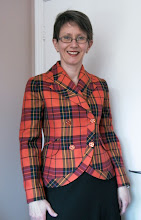Without further ado, here are the pants I made to go with my garden camo jacket.

They may never be seen in combination again, so enjoy!
 |
| Fly front - with snap! |
This is yet another iteration of the Shop Pants from Open Studio Patterns. I mean, once you adjust a pattern to fit, why not make it to death?
There are lots of details, but they are totally invisible.
Topstitching!
Pockets!
Fly front!
As the linen fabric is a bit scratchy and underlining helps with wrinkling, I underlined the main body pieces with the cotton lining fabric from the original curtains. I also used the cotton for the pocket bags and to face the waistband.
They look good with this extremely monochromatic top. Which was the entire plan.
I continue to tweak the pattern. After assembling, I scooped the crotch a bit for more sitting room (maybe 1cm). I also added fusible stay tape on the upper edge of the waistband to shorten the upper edge (eased waistband as I was fusing) because it needed to be a bit more curved than it was.
I didn't adjust the upper edge of the front and back pieces but I think I could handle a tiny bit more height in the centre back. Like maybe .5cm.
I didn't do any further adjustments to the paper pattern. (Hope I remember to check this before making again...)
At the waist, I installed a snap closure (because I could not make a buttonhole with the available machinery in the thickness of this waistband).
I used a green plastic snap leftover from when my son (now mid-30s) was a toddler. They go in with the red tool as pictured in the following photos. (This is 100% written about so I will be able to refer back the next time I get a hankering to put one of these snaps onto a garment. My blog is my external memory.)
To apply the the visible part, place the plastic button face down in the little cup. Put the RIGHT SIDE of the overlap side of the garment against it so that the centre of the button, which pokes up a tiny bit, is visible through the little hole previously punched in the correct place.






